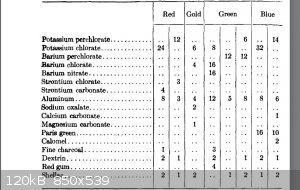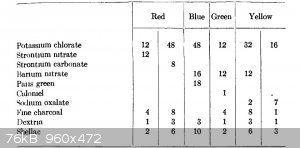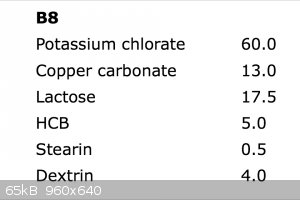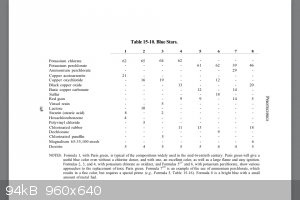sum
Harmless

Posts: 20
Registered: 9-1-2015
Member Is Offline
Mood: No Mood
|
|
Paris green and various substitutes for blue stars
Anyone tell me about copper(||)acetoarsenite (Paris green).M.For.-cu(c2h3o2)2.3cu(aso2)2.
|
|
|
sum
Harmless

Posts: 20
Registered: 9-1-2015
Member Is Offline
Mood: No Mood
|
|
copper(||)acetoarsanite (paris green)
|
|
|
Bert
Super Administrator
        
Posts: 2821
Registered: 12-3-2004
Member Is Offline
Mood: " I think we are all going to die. I think that love is an illusion. We are flawed, my darling".
|
|
Quote: Originally posted by sum  | | Anyone tell me about copper(||)acetoarsenite (Paris green).M.For.-cu(c2h3o2)2.3cu(aso2)2. |
PLEASE read the FAQ about posting-
Particularly, this:
| Quote: |
Questions that provide background information and show effort are more likely to receive good responses.
|
I understand that English may not be your first language, but you need to more exactly tell people what your question is.
Also: there are books in the Sciencemadness.org library that have information on what (my best guess?!) you are interested in. Try looking in Tenney Davis Chemistry of Powder
and Explosives.
Paris green is considered an obsolete material in commercial fireworks making in the USA. Other Copper compounds have replaced it such as Copper
oxide, Copper carbonate, Copper oxychloride or Copper benzoate.
Rapopart’s Rules for critical commentary:
1. Attempt to re-express your target’s position so clearly, vividly and fairly that your target says: “Thanks, I wish I’d thought of putting it
that way.”
2. List any points of agreement (especially if they are not matters of general or widespread agreement).
3. Mention anything you have learned from your target.
4. Only then are you permitted to say so much as a word of rebuttal or criticism.
Anatol Rapoport was a Russian-born American mathematical psychologist (1911-2007).
|
|
|
sum
Harmless

Posts: 20
Registered: 9-1-2015
Member Is Offline
Mood: No Mood
|
|
OK.I read FAQ(not proper way) but understand what I do.and about English in India its compulsory to read because this is international language.(my
thinking we are fool not wise as Chinese) . u r right Mr.Bert that is our 2nd language.matter is that in ever formula have Paris green but here no one
known about this copper compound.some one says that is ban item so I ask 4 this,..........
|
|
|
Bert
Super Administrator
        
Posts: 2821
Registered: 12-3-2004
Member Is Offline
Mood: " I think we are all going to die. I think that love is an illusion. We are flawed, my darling".
|
|
You still have not said WHAT you want to make! Is it blue fireworks stars.
Below, these are OBSOLETE mixtures. Paris green for Copper, calomel (mercurous chloride, Hg2Cl2) as a chlorine donor- FOR INFORMATION ONLY! Do not try
to make, even if you could find the chemicals, these are mixtures from 100 years ago or more.
  m m
This is a (more modern!) blue star mixture WITH Potassium chlorate and WITHOUT Paris green. HCB is hexachlorobenzene.

Below is a range of mixtures, showing some more modern materials without use of Paris green.

[Edited on 14-1-2015 by Bert]
Rapopart’s Rules for critical commentary:
1. Attempt to re-express your target’s position so clearly, vividly and fairly that your target says: “Thanks, I wish I’d thought of putting it
that way.”
2. List any points of agreement (especially if they are not matters of general or widespread agreement).
3. Mention anything you have learned from your target.
4. Only then are you permitted to say so much as a word of rebuttal or criticism.
Anatol Rapoport was a Russian-born American mathematical psychologist (1911-2007).
|
|
|
sum
Harmless

Posts: 20
Registered: 9-1-2015
Member Is Offline
Mood: No Mood
|
|
I am sorry sir.I want to say what is that compound and how its make.no information on net. Try to get this but no one know it and some says this is
ban item.(plz handle my English).thanks
HCB is also ban compound in India or not sale any person(only industrial uses).
|
|
|
woelen
Super Administrator
        
Posts: 7977
Registered: 20-8-2005
Location: Netherlands
Member Is Offline
Mood: interested
|
|
There is a good reason for banning Paris green in fireworks. It is VERY toxic due to its arsenic content. I hardly can imagine that this once was a
main source for blue colors in fireworks. There are so many other perfectly suitable copper compounds, it is the copper which gives the blue color,
not the arsenic, so other copper compounds do the job as well.
The same is true for HgCl2. This also certainly should not have a place in fireworks, due to its mercury content. If you want chlorine in fireworks,
then there are many other alternatives. Even stuff like HCB is not as nasty, especially if only a small amount of this is used and all of it is burned
up in the composition leaving behind only CO2/carbonate and chloride.
In the Netherlands nowadays the use of lead compounds is banned as well. Consumer fireworks must be free of lead, e.g. PbO2 may not be used anymore as
oxidizer. Certain crackling mixes (Bert certainly knows the details about them) are not allowed anymore, but I'm sure there are alternatives for that
as well. IIRC bismuth(III) oxide is a suitable alternative, although that stuff is quite expensive.
There even are voices, advocating the banning of barium salts in fireworks, but in practice, these still are used extensively in fireworks.
|
|
|
Bert
Super Administrator
        
Posts: 2821
Registered: 12-3-2004
Member Is Offline
Mood: " I think we are all going to die. I think that love is an illusion. We are flawed, my darling".
|
|
Quote: Originally posted by sum  | I am sorry sir.I want to say what is that compound and how its make.no information on net. Try to get this but no one know it and some says this is
ban item.(plz handle my English).thanks
HCB is also ban compound in India or not sale any person(only industrial uses). |
Can you get Copper carbonate or black Copper oxide. Both work just fine-
Chlorinated rubber (Parlon), PVC, Saran resin, chlorinated wax- All will replace hexachlorobenzene, with some adjustment for their different weight %
Chlorine content, and differing fuel values.
If you want to make SMALL STARS, no bigger than 3mm Dia.! A good mix is Potassium chlorate (oxidizer), black Copper oxide (colorant) and lactose (both
fuel and binder). The Chlorine content of the chlorate is just enough so no additional chlorine donor is required. Color goes bad, becomes pale and
greenish if stars are too big though!
As Woelen says, don't bother to make Paris green. It is not needed, learn to replace it with safer chemicals.
Rapopart’s Rules for critical commentary:
1. Attempt to re-express your target’s position so clearly, vividly and fairly that your target says: “Thanks, I wish I’d thought of putting it
that way.”
2. List any points of agreement (especially if they are not matters of general or widespread agreement).
3. Mention anything you have learned from your target.
4. Only then are you permitted to say so much as a word of rebuttal or criticism.
Anatol Rapoport was a Russian-born American mathematical psychologist (1911-2007).
|
|
|
Fantasma4500
International Hazard
    
Posts: 1677
Registered: 12-12-2012
Location: Dysrope (aka europe)
Member Is Offline
Mood: dangerously practical
|
|
i think he just wanted to know where to get hold of some arsenic compounds well fitting for fireworks, im not sure if he has even considered there may
be better alternatives..
anyhow, if you want to make it, it would seem as mixing 1 mole
Cu(C2H3O2)2 and 3 moles Cu(AsO2)2.
i would however strongly disadvice you to attempt this, not sure if im able to express why.. 
|
|
|
Bert
Super Administrator
        
Posts: 2821
Registered: 12-3-2004
Member Is Offline
Mood: " I think we are all going to die. I think that love is an illusion. We are flawed, my darling".
|
|
When I was a teen, and wooly mammoths roamed the land, ARPA NET didn't let kids search for information "on line" (and our Heath Kit computers mostly didn't have modems anyhow).
So I read books. OLD BOOKS. And found that heating thin Copper wire in a covered crucible under an excess of Sulfur produced black Copper sulfide.
Which DID work as a blue flame colorant in chlorate mixtures, albeit sensitizing them greatly... A version of the sugar blue posted above, made with
sucrose. Another version made with clear shellac as binder, straight from a can of Zinser. Not the best, but it was blue!
My crucible was a 4" long piece of 1 1/2" Dia. Iron pipe with 2 end caps. Upper cap had a small hole drilled to relieve gas pressure. It worked. God,
it was hard to grind that Copper sulfide.
[Edited on 15-1-2015 by Bert]
Rapopart’s Rules for critical commentary:
1. Attempt to re-express your target’s position so clearly, vividly and fairly that your target says: “Thanks, I wish I’d thought of putting it
that way.”
2. List any points of agreement (especially if they are not matters of general or widespread agreement).
3. Mention anything you have learned from your target.
4. Only then are you permitted to say so much as a word of rebuttal or criticism.
Anatol Rapoport was a Russian-born American mathematical psychologist (1911-2007).
|
|
|
Fantasma4500
International Hazard
    
Posts: 1677
Registered: 12-12-2012
Location: Dysrope (aka europe)
Member Is Offline
Mood: dangerously practical
|
|
recall to have use copper powder from CuCl2 and Al, and heated it with sulfur, im almost totally certain i had a sulfide produced, this was proven by
excessively heating the thing until no more sulfur was left and acid was added to the powder that was left behind, or well at least solid
i wonder if you could just run electrolysis of molten sulfur with copper?
|
|
|
Bert
Super Administrator
        
Posts: 2821
Registered: 12-3-2004
Member Is Offline
Mood: " I think we are all going to die. I think that love is an illusion. We are flawed, my darling".
|
|
Why bother with electrolysis when the fused method is so easy?
Copper doesn't need to be powdered, reaction might be faster than liked with too small particle size- And perhaps then your CuS is all over the hood
instead of staying in the crucible nicely? Have you ever mixed fine Zinc powder and Sulfur, then heated? FLASH!
When we made CuS in high school chemistry as first part of the "Copper lab", we wound some clean electrical copper wire into a spiral over a pencil,
and the sulfide formed was in the exact shape and size of Copper spiral we had put into the crucible
Rapopart’s Rules for critical commentary:
1. Attempt to re-express your target’s position so clearly, vividly and fairly that your target says: “Thanks, I wish I’d thought of putting it
that way.”
2. List any points of agreement (especially if they are not matters of general or widespread agreement).
3. Mention anything you have learned from your target.
4. Only then are you permitted to say so much as a word of rebuttal or criticism.
Anatol Rapoport was a Russian-born American mathematical psychologist (1911-2007).
|
|
|